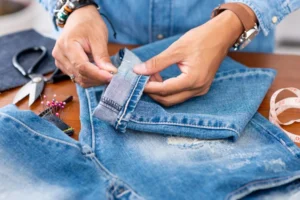We live in a world where people are finally getting more environmentally conscious. This approach can be seen in how we are all collectively looking for more eco-friendly products and processes. Thousands of earth lovers are now actively raising awareness on the potential dangers future generations will face if we proceed with our destructive behavior toward the planet. The fashion industry is not an exception. Many world-renowned brands have already turned to the production and use of greener textiles to enhance their reputation and target a more intellectual market. Now, along with recycling and consuming less, we can find garments and materials to reduce our carbon footprint. Here are five sustainable fabrics that could contribute remarkably to a more eco-conscious, organic lifestyle.

Pineapple Leather
Nowadays, leather from fruits is beginning to gain traction worldwide among sustainable fashion designers. Pineapple leather is one such fabric on the lead in the fashion industry. It is a simulation of leather fabricated from a blend of pineapple fibers, petroleum-based resin, and thermoplastic polyester. This leather, also known as Pinatex, is presented in many colors and textures and can be utilized to make bags, shoes, boots, upholstery, and fashion accessories. Although it’s been around for only a short while, its durability and sturdiness have made it a trendy material throughout the fashion industry.
Unlike most popular leathers, no animal by-products are used in Pinatex fabrication. It is also recyclable to a great extent, thanks to its biodegradable leaf fibers. However, not all of it is easy to recycle due to its plastic and resin constituents. Still, as a more sustainable leather, it has a combination of properties similar to both natural and faux leather. It is water-resistant, heat-resistant, soft, durable, flexible, and above all, breathable. Pinatex can look attractive and function well for several years if maintained well, re-waxed periodically, and stored appropriately. So, if you’re considering purchasing a leather product, why not try Pinatex this time as a sustainable fabric?
Lyocell
During the last decades, environmentalists have tried their best to raise awareness regarding the harmful impact of microfibers. When we wash clothes made from artificial fibers, they release microfibers into water channels through our washing machines. Since these microfibers are potential threats to many species, finding natural, eco-friendly fibers has taken a high priority for most earth lovers. One such sustainable fabric is called Lyocell, a form of rayon consisting of cellulose fiber derived from wood pulp. It is a breathable textile that has revolutionized the fashion world with its green qualities. Lyocell is generally used for producing eco-friendly underwear, ethical jeans, sustainable towels, dress shirts, etc.
Lyocell is manufactured under the brand name “Tencel” by an Austrian company. As a wood-based product, it is biodegradable and compostable, and its production has a low environmental impact. It can also be mixed with other fabrics like polyester, cotton, ethical wool, acrylic, and peace silk to cater to a broader range of purposes. However, if mixed with other synthetic fibers, the new textile won’t be compostable anymore. Above all, Lyocell’s elastic and moisture-absorbent properties make it a brilliant choice for athletic wear. That’s why some companies, such as Selfridges & Co., have labeled the fiber as a “Miracle Fabric.”
Linen
Without a doubt, linen is a long-lasting, sustainable fabric that’s been serving humankind since prehistoric times. Numerous studies reveal that Neolithic societies in Europe made fabrics from linen almost 36,000 years ago. Ancient Egyptians also admired linen for its durability and capability to absorb water and keep people cool. This fabric was considered so precious that it was also used as a genuine type of currency or for making the burial coverings for mummies. Today, manufacturers use linen for the same reasons as before; but this sustainable fabric comprises a dramatically smaller fraction of the universal fabric market. The painstaking and time-consuming processes used for producing linen have made it no longer affordable for the general public. It primarily serves a niche market with many expensive products, including bags, aprons, towels, napkins, tablecloths, chair covers, runners, bedding, etc.
Linen is produced from flax fibers that are diligently extracted, spun into threads, and later woven into extended sheets of soft, comfortable fabric. If grown in geographically suitable regions, like Europe, it would require no pesticides or fertilizers and would need a great deal less water than cotton while also being suitable for soil health. The fabric itself is hard-wearing in the real sense, and you don’t need to replace it for years. It also dries faster than cotton and other textiles, so it has all it needs to be a sustainable fabric for the affluent. If you are one, don’t hesitate to indulge yourself with a linen item of clothing!

Hemp
Hemp refers to a specific species of the Cannabis plant grown particularly for medicinal or industrial purposes. The hemp fiber is used to produce various goods, including ropes, shirts, jeans, bags, and hats. It is even used in fabricating cosmetics, skincare, paper products, and a wide variety of food. Like bamboo, it is one of the fastest-growing plants that causes very little soil erosion and no need for chemical pesticides. It also needs a small-sized farm to grow and consumes %50 less water than cotton. In a nutshell, this organic fabric ticks all the boxes for moving toward natural, sustainable fibers.
Hemp clothing is three times stronger than cotton. That’s why its first fabrication dates back to over 10,000 years ago. It is also lightweight, absorbent, and weather-resistant, making it suitable for outdoor wear. It can also be mixed with other fibers to provide a more diverse range of qualities in clothing. For instance, you can purchase hemp/cotton or hemp/silk garments for more comfort. There are some dedicated hemp clothing stores, like Hemp Authority and Vital Hemp, at which you can buy everything you need from head to toe.
Modal
Also known as underwear fabric, Modal is changing the fashion industry for good with its stretchy, lightweight nature. It is an innovative semi-synthetic textile made from fibers of the beechwood tree. Modal is preferable to cotton and Lyocell in some aspects like its durability, delicacy, and smoothness. However, it is pricier and less breathable. It also absorbs 50% more water than cotton, making it the best choice for undergarments, pajamas, bathrobes, and activewear. Many clothing brands use it as an eco-conscious substitute for viscose or other kinds of rayon. Plus, it hardly ever shrinks and bleeds dye during the washing process.
LenzingTM is the Austrian corporation behind Modal. Thanks to its non-toxic, sustainable processes, Lenzing recycles up to 95% of materials utilized in the fabrication of Modal yarn. This process minimizes the fabric’s total carbon footprint, making it a green choice for the fashion industry. So, if you are on the lookout for a luxury, green textile that has a high-end feel, consider Modal on your next hunt.
Last Word
These are only a handful of eco-friendly fabrics changing the fashion world toward a greener, more sustainable future. Therefore, whenever you are shopping for a new garment, look out for these five green textiles. As mentioned above, buying greener could also mean buying more durable products that could prove beneficial to you and the planet in the long run.



